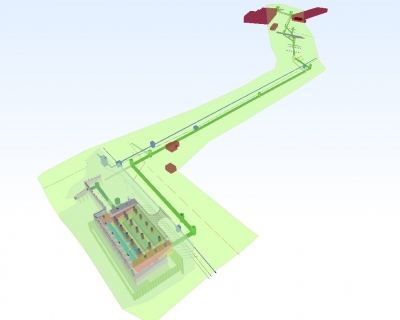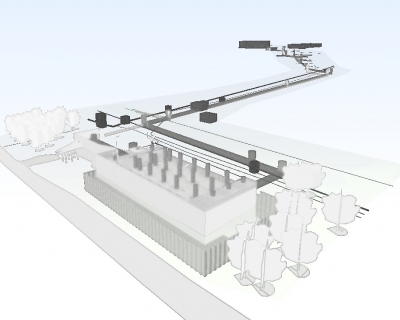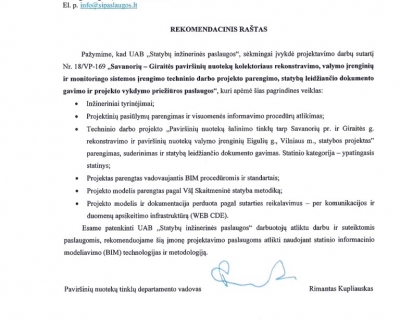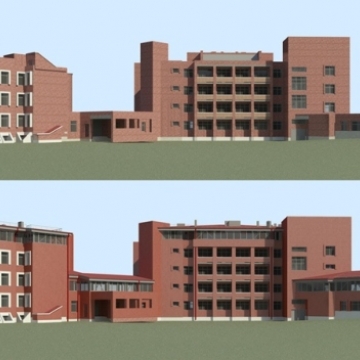Reconstruction of the Savanorių–Giraitė Stormwater Collector, Construction of Treatment Facilities and Monitoring System
- Home
- Our Projects
|
|
UAB Statybų inžinerinės paslaugos successfully completed the design contract for the technical project preparation, permitting, and project supervision services related to the reconstruction of the stormwater collector and the installation of treatment and monitoring systems.
The project involves the reconstruction of existing stormwater drainage networks (DN1000, DN1200, DN1600, DN1800 mm), installation of new stormwater treatment facilities, and implementation of a monitoring system. A service area measuring 26.70 x 14.40 m is planned above the treatment facilities, including access and paving with concrete blocks. A pedestrian walkway with similar paving will be constructed around the service area, accompanied by a reinforced concrete retaining wall with safety railings.
The walkway between the retaining wall and the service area will serve as a public viewing platform, offering scenic views of the Neris River and the Žvėrynas district of Vilnius. Benches and lighting will be installed to enhance the area’s accessibility and comfort.
The total catchment area for collected stormwater is approximately 188.5 hectares.
The project involves the rehabilitation of DN1000 and DN1200 mm stormwater drainage pipelines located between Savanorių Avenue and Giraitės Street. The existing pipelines are constructed from reinforced concrete.
The section between manholes LRK-162 and LRK-34-114 is being rehabilitated using a trenchless Cured-In-Place Pipe (CIPP) method, applying flexible polymer or fiberglass liners. Prior to lining, the pipelines are cleaned using hydrodynamic jetting equipment. A subsequent CCTV inspection is carried out to identify and remove any obstructions, such as pipe fragments, tree roots, or other debris.
Following the inspection, the exact locations of existing lateral connections and branch lines are determined to ensure proper integration with the main network. After the rehabilitation works are completed, a final televised inspection is conducted to verify the condition and functionality of the reconstructed pipelines.
Reinforced concrete manholes within the reconstructed sections are repaired, and new utility marking posts and identification plates are installed for all rehabilitated manholes.
The section between manholes LRK-34-114 and LK-1 is being reconstructed using an open-trench method. Existing DN1000 reinforced concrete pipelines are being replaced with DN1600 fiberglass pipes to increase hydraulic capacity and improve durability.
The subsequent section, extending from manhole LK-1 to the proposed stormwater treatment facilities, is also constructed using an open-trench approach, utilizing DN1800 fiberglass pipes. These larger-diameter pipes are designed to accommodate increased flow volumes and ensure long-term structural integrity.
Within the stretch from LRK-34-114 to the treatment facility site, new prefabricated fiberglass manholes are planned. These manholes are monolithic, factory-manufactured units engineered to resist soil displacement, frost, vertical loads, and groundwater infiltration, ensuring reliable performance under varying environmental conditions.
The stormwater treatment facilities are designed to be installed upstream of the existing outlet No. 1-142-137. The treatment system will include:
- Flow distribution chamber with flow regulators
- Sand and sludge sedimentation units
- Oil-water separators with integrated sedimentation and automatic emergency shut-off valves
- Flow collection chamber with shut-off valve
- Bypass line
- Monitoring unit
Three treatment modules are designed, each with a capacity of 510 l/s. A monitoring and flow measurement unit will be installed downstream of the treatment facilities, before the outlet.
Monitoring System Features:
- Measurement of pollutant levels in the treatment units
- Local and remote control of automatic shut-off valves
- Monitoring of pollution indicators in stormwater discharged into the Neris River
- Automatic sampling equipment
Upon completion of the reconstruction and installation works, the project will significantly reduce surface water pollution and improve overall environmental conditions. The newly constructed stormwater treatment facilities will enhance the quality of water discharged into the Neris River and contribute to ecosystem stability.
The project was developed in accordance with BIM (Building Information Modeling) procedures and standards.



